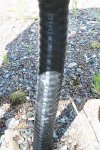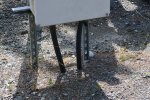The appearance is exacly that of MC-HL, corrogated, continuous sheath
Several manufactruers, General, USA, Okonite (CL-Xx).
For the north, for under-ground transitions areas, it is godsend. It does not buckle and tear the boxes apart like rigid will.
Works extremely well for underground. The plastic sheath protects from most of the stuff in 330.12. Conduit breaks at the joints (couplings) and rusts, yes, even galvanized. No, it does not fill up with water.
End fittings are TMC or TMCX. TMCX are potted and used in classified areas. Suitable for CI, CII, CIII, Div 1, Div 2.
NEC requires protection. In areas of vehicle trafic, I'll use a couple of bollards to keep the trucks from parking on it. Not much diffrerent thaqn one would use for protecting rigid in a process area.
I like it, use it in lieu of rigid any time possible.
the worm




